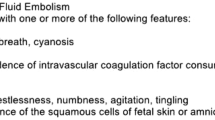Abstract
Amniotic fluid embolism (AFE) continues to be one of the most feared and devastating complications of pregnancy. A reliable diagnosis can be made only upon histological examination. A detection of AFE every now and then has a relevant implication on medico-legal aspects of intrapartum or post-partum maternal death. However, there are only isolated reports in the literature concerning the detection interval of amniotic fluid elements after their transfer into the lungs. The objective of this study was to determine how long after the onset of clinical symptoms the elements of amniotic fluid may be detectable in the pulmonary circulation. An autopsy, as well as a histological and toxicological examination of 29 women, who died intrapartum or post-partum were performed. AFE was diagnosed in seven women (25%). The maximum survival time of the women with AFE and also the detection interval of AF in the pulmonary vasculature was 36 h. In the lungs of the women who did not die of AFE, amniotic fluid components were not found. Thus, there is no evidence for a physiologic occurrence of AFE. In women who die some days or even weeks after delivery as a consequence of a haemorrhagic shock following post-partum genital bleeding ensuing from uterine atony, AFE should be considered as a cause of a coagulopathy.








Similar content being viewed by others
References
Kramer MS, Rouleau J, Baskett TF et al (2006) Maternal Health Study Group of the Canadian Perinatal Surveillance System. Amniotic-fluid embolism and medical induction of labour: a retrospective, population-based cohort study. Lancet 368:1444–1448
Meyer JR (1926) Embolia pulmonar amnio-caseosa. Brasil Medico 2:301–303
Steiner PE, Lushbough CC (1941) Maternal pulmonary embolism by amniotic fluid as a cause of shock and unexplained deaths in obstetrics. JAMA 117:1245–1245
Gilbert WM, Danielsen B (1999) Amniotic fluid embolism: decreased mortality in a population-based study. Obstet Gynecol 93:973–977
Clark SL, Hankins GD, Dudley DA et al (1995) Amniotic fluid embolism: analysis of the national registry. Am J Obstet Gynecol 172:1158–1167
Tuffnell DJ (2005) United Kingdom amniotic fluid embolism register. BJOG 112:1625–1629
Lau G (1994) Amniotic fluid embolism as a cause of sudden maternal death. Med Sci Law 34:213–220
Tuller MA (1957) Amniotic fluid embolism, afibrinogenemia, and disseminated fibrin thrombosis; case report and review of the literature. Am J Obstet Gynecol 73:273–287
Nadjem H, Bohnert M, Pollak S (2001) Zur Kasuistik der letalen Fruchtwasserembolie. Arch Kriminol 207:89–96
Christiansen LR, Collins KA (2006) Pregnancy-associated deaths: a 15-year retrospective study and overall review of maternal pathophysiology. Am J Forensic Med Pathol 27:11–19
Rushton DI, Dawson IMP (1982) The maternal autopsy. J Clin Pathol 35:909–921
Keeling J, Gray ES (2003) Maternal death. In: Payne-James J, Busuttil A, Smock W (eds) Forensic medicine. Clinical and pathological aspects, 1st edn. Bath Press, Bath, pp 215–230
Attwood HD, Delprado WJ (1988) Amniotic fluid embolism: fatal case confirmed at autopsy five weeks after delivery. Pathology 20:381–382
Kaptanoglu M, Dogan K, Onen A et al (1999) Lung mass due to amniotic fluid embolism—an intrathoracic complication of pregnancy. Scand Cardiovasc J 33:117–119
Kuhlman K, Hidvegi D, Tamura RK et al (1985) Is amniotic fluid material in the central circulation of peripartum women pathologic? Am J Perinatol 2:295–299
Sh D (2001) Amniotic fluid embolism: a review of the literature. Can J Anaesth 48:88–98
St-Amand J (1993) Medicolegal nightmare: a tragic case, a needless trial. CMAJ 148:806–809
Nishio H, Matsui K, Miyazaki T et al (2002) A fatal case of amniotic fluid embolism with elevation of serum mast cell tryptase. Forensic Sci Int 126:53–56
Fineschi V, Gambassi R, Gherardi M, Turillazzi E (1998) The diagnosis of amniotic fluid embolism: an immunohistochemical study for the quantification of pulmonary mast cell tryptase. Int J Legal Med 111:238–243
Marcus BJ, Collins KA, Harley RA (2005) Ancillary studies in amniotic fluid embolism: a case report and review of the literature. Am J Forensic Med Pathol 26:92–95
Högberg U, Joelsson I (1985) Amniotic fluid embolism in Sweden, 1951–1980. Gynecol Obstet Invest 20:130–137
Peterson EP, Taylor HB (1970) Amniotic fluid embolism. An analysis of 40 cases. Obstet Gynecol 35:787–793
Bastien JL, Graves JR, Bailey S (1998) Atypical presentation of amniotic fluid embolism. Anesth Analg 87:124–126
Kingston NJ, Baillie T, Chan YF et al (2003) Pulmonary embolization by chorionic villi causing maternal death after a car crash. Am J Forensic Med Pathol 24:193–197
Yamamoto K, Yamamoto Y, Watanabe H et al (1989) A case of sudden death by decidual cell embolism. Z Rechtsmed 102:415–419
Roche WD Jr, Norris HJ (1974) Detection and significance of maternal pulmonary amniotic fluid embolism. Obstet Gynecol 43:729–731
Acknowledgments
The authors are deeply grateful to “Wissenschaftliches Herausgeberkollegium der München Medizinischen Wochenschrift e. V.” for valuable support.
Author information
Authors and Affiliations
Corresponding author
Additional information
Dedicated to Prof. Dr. W. Eisenmenger, my teacher, on the occasion of his 65th birthday
Rights and permissions
About this article
Cite this article
Sinicina, I., Pankratz, H., Bise, K. et al. Forensic aspects of post-mortem histological detection of amniotic fluid embolism. Int J Legal Med 124, 55–62 (2010). https://doi.org/10.1007/s00414-009-0351-x
Received:
Accepted:
Published:
Issue Date:
DOI: https://doi.org/10.1007/s00414-009-0351-x



